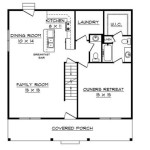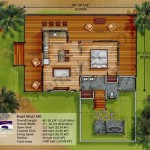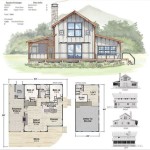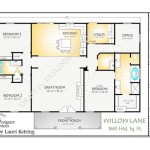Studio house plans are architectural designs that provide a living space within a single room. These plans typically include an open floor plan that encompasses the bedroom, living area, and kitchen in one continuous space. Studio apartments are often found in urban areas where space is limited and affordability is a concern.
The simplicity and efficiency of studio house plans make them an attractive option for individuals or couples who value functionality and coziness. They are also popular as vacation rentals or guest houses, offering a comfortable and convenient space for short-term stays.
In the following sections, we will delve into the specific characteristics of studio house plans, exploring their advantages and disadvantages, and providing tips for designing and furnishing these compact living spaces.
Studio house plans offer a range of advantages and considerations:
- Compact and efficient
- Affordable and budget-friendly
- Open and airy floor plan
- Multi-functional space
- Lower utility costs
- Less maintenance required
- May feel cramped
- Limited storage space
Overall, studio house plans provide a practical and cost-effective solution for individuals or couples seeking a comfortable and functional living space.
Compact and efficient
One of the primary advantages of studio house plans is their compact and efficient design. By combining the bedroom, living area, and kitchen into a single room, studio apartments maximize space utilization and minimize wasted square footage.
This compact design makes studio house plans ideal for individuals or couples who value functionality and efficiency. They are also a great option for urban dwellers where space is often limited and affordability is a concern.
The open floor plan of studio apartments creates a sense of spaciousness and allows for multiple uses of the same space. For example, the living area can double as a dining area or home office, while the kitchen can be used as a workspace or breakfast nook.
Overall, the compact and efficient design of studio house plans makes them a practical and cost-effective solution for individuals seeking a comfortable and functional living space.
In addition to their space-saving benefits, studio house plans are also more energy-efficient than larger homes. With a smaller footprint, they require less energy to heat and cool, resulting in lower utility costs.
Affordable and budget-friendly
Studio house plans are generally more affordable and budget-friendly compared to larger homes. This affordability stems from several factors:
- Smaller size: Studio apartments are typically smaller than traditional homes, which means they require less building materials and labor to construct. This reduced construction cost translates into lower purchase prices for buyers.
- Fewer amenities: Studio apartments often have fewer amenities than larger homes, such as separate bedrooms, multiple bathrooms, or outdoor space. The absence of these amenities further contributes to the affordability of studio house plans.
- Lower property taxes: Due to their smaller size and value, studio apartments typically have lower property taxes than larger homes. This ongoing savings can make a significant difference in the long run.
- Reduced utility costs: The compact size of studio apartments makes them more energy-efficient to heat and cool, resulting in lower utility costs for occupants.
Overall, the affordable and budget-friendly nature of studio house plans makes them an attractive option for first-time homebuyers, individuals on a tight budget, or those seeking a low-maintenance and cost-effective living space.
Open and airy floor plan
Studio house plans typically feature an open and airy floor plan, which is a key factor contributing to their spacious and inviting feel.
The open floor plan eliminates traditional walls and partitions, creating a continuous and interconnected living space that encompasses the bedroom, living area, and kitchen. This seamless flow of space allows for maximum natural light penetration, making the apartment feel larger and brighter.
The absence of walls also fosters a sense of openness and freedom of movement. Bewohner can easily navigate the space and interact with different areas without feeling confined or restricted.
Moreover, the open floor plan provides greater flexibility in furniture arrangement and room usage. Bewohner can customize the space to suit their individual needs and preferences, creating a truly personalized living environment.
The open and airy floor plan of studio house plans offers a range of benefits, including:
- Increased natural light
- Enhanced sense of spaciousness
- Improved air circulation
- Greater flexibility and functionality
These benefits combine to create a comfortable and inviting living space that is both practical and aesthetically pleasing.
Multi-functional space
One of the key advantages of studio house plans is their ability to serve multiple functions within a single room. This multi-functionality stems from the open floor plan and lack of traditional walls, which allows Bewohner to customize the space to suit their individual needs and preferences.
- Sleeping area: The sleeping area is typically defined by a bed and nightstand, but it can be further customized with curtains, a room divider, or a loft bed to create a more private and cozy space.
- Living area: The living area typically consists of a sofa, armchair, and coffee table, but it can also double as a dining area or home office. With careful space planning, Bewohner can create a comfortable and functional living space that meets their unique needs.
- Kitchen area: The kitchen area typically includes a refrigerator, stove, oven, and sink, but it can be expanded to accommodate a dishwasher, microwave, or additional counter space. By incorporating smart storage solutions and space-saving appliances, Bewohner can create a fully functional kitchen in a compact space.
- Storage space: Storage is often a concern in studio house plans, but with clever design and space-saving solutions, Bewohner can maximize storage capacity. Built-in shelves, under-bed storage, and multi-purpose furniture can help keep the space organized and clutter-free.
The multi-functional nature of studio house plans offers a range of benefits, including:
- Increased flexibility and adaptability
- Efficient use of space
- Personalized and customized living environment
- Reduced need for additional furniture or storage units
By embracing the multi-functional potential of studio house plans, Bewohner can create a comfortable, stylish, and practical living space that meets their individual needs and preferences.
Lower utility costs
Studio house plans offer lower utility costs compared to larger homes due to their smaller size and energy-efficient design.
The compact size of studio apartments means they require less energy to heat and cool. This is especially advantageous in extreme climates, where heating and cooling costs can be a significant expense. By reducing energy consumption, Bewohner can save money on their monthly utility bills.
In addition to their smaller size, studio house plans often incorporate energy-efficient features such as:
- Energy-efficient appliances: Studio apartments are typically equipped with energy-efficient appliances, such as refrigerators, dishwashers, and washing machines. These appliances consume less energy, further reducing utility costs.
- Good insulation: Studio apartments are often well-insulated, which helps to maintain a comfortable indoor temperature and reduce heat loss. Good insulation can also reduce the need for heating and cooling, leading to lower energy bills.
- Double-glazed windows: Double-glazed windows help to insulate the apartment and reduce heat loss. They also help to block out noise, creating a more peaceful and comfortable living environment.
Overall, the smaller size and energy-efficient features of studio house plans contribute to lower utility costs, making them a more affordable and sustainable option for individuals and couples.
In addition to the energy-saving features mentioned above, studio house plans often have lower water consumption compared to larger homes. This is due to their smaller size and reduced number of fixtures and appliances. By conserving water, Bewohner can further reduce their utility costs and contribute to environmental sustainability.
Less maintenance required
Studio house plans require less maintenance compared to larger homes due to their smaller size and reduced number of rooms and features.
With a smaller living space, there is less cleaning, dusting, and general upkeep required. Bewohner can spend less time on household chores and more time enjoying their free time.
Studio apartments also have fewer rooms and features to maintain. For example, they typically have one bathroom instead of two or more, and they may not have a separate laundry room or storage space. This reduces the need for cleaning, repairs, and maintenance in these areas.
Additionally, studio house plans often have simpler designs and finishes. This means there are fewer complex systems and materials to maintain, such as multiple electrical circuits, plumbing fixtures, or intricate moldings.
Overall, the smaller size, reduced number of rooms and features, and simpler designs of studio house plans contribute to less maintenance required, making them a more low-maintenance and hassle-free option for individuals and couples.
May feel cramped
One potential disadvantage of studio house plans is that they may feel cramped, especially for individuals or couples who are accustomed to more spacious living quarters. The compact size of studio apartments can limit the amount of furniture and personal belongings that can be comfortably accommodated.
The lack of separate rooms can also contribute to a feeling of crampedness. With all activities taking place in a single room, Bewohner may feel a lack of privacy and separation between different areas of their life, such as sleeping, working, and entertaining.
However, it is important to note that the perception of crampedness can vary widely depending on individual preferences and lifestyle. Some people may find that the compact size of a studio apartment fosters a sense of coziness and intimacy, while others may prefer the spaciousness and privacy of a larger home.
To mitigate the potential for feeling cramped, there are several design strategies that can be employed:
- Maximize natural light: Natural light can make a space feel larger and more inviting. By incorporating large windows or skylights, Bewohner can bring in ample natural light and create a more spacious feel.
- Use light colors: Light colors reflect light and make a space feel larger. Avoid using dark or heavy colors, which can make a small space feel even more cramped.
- Choose multi-functional furniture: Multi-functional furniture can save space and reduce clutter. For example, a sofa bed can serve as both a seating area and a sleeping area, while a coffee table with built-in storage can provide additional storage space without taking up extra floor space.
- Declutter and organize: Clutter can make a space feel smaller and more cramped. Regularly declutter and organize your belongings to keep the space feeling neat and spacious.
By carefully considering these design strategies and adapting them to their individual needs and preferences, Bewohner can create a studio house plan that feels comfortable, spacious, and inviting.
Limited storage space
Studio house plans often have limited storage space due to their compact size and lack of separate storage areas, such as closets or pantries. This can be a challenge for Bewohner who have a lot of belongings or who need to store bulky items.
However, there are several design strategies that can be employed to maximize storage space in studio house plans:
- Utilize vertical space: Vertical space is often underutilized in studio apartments. By installing shelves, drawers, and cabinets that extend upwards, Bewohner can create additional storage without taking up valuable floor space.
- Use multi-functional furniture: Multi-functional furniture can provide both storage and seating or sleeping space. For example, a bed with built-in drawers can provide additional storage for clothing or linens, while a sofa with built-in storage can provide a place to store blankets, pillows, or other items.
- Install wall-mounted storage: Wall-mounted storage, such as floating shelves and pegboards, is a great way to add extra storage without taking up floor space. Wall-mounted storage can be used to store a variety of items, such as books, plants, artwork, or kitchen supplies.
- Utilize hidden storage: Hidden storage can be created by using the space under beds, behind doors, or inside walls. This type of storage is ideal for items that are not frequently used or that need to be kept out of sight.
By carefully considering these design strategies and adapting them to their individual needs and preferences, Bewohner can create a studio house plan that provides adequate storage space without feeling cluttered or cramped.
In addition to the design strategies mentioned above, Bewohner can also declutter and organize their belongings to maximize storage space. Regularly decluttering and getting rid of items that are no longer needed can free up valuable space. Additionally, using organizational tools, such as baskets, bins, and drawer dividers, can help to keep belongings organized and easily accessible.










Related Posts








